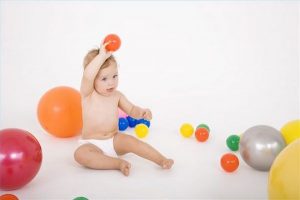 When parents of toddlers talk about throwing, it’s often about discipline: How do I teach my child not to throw food on the floor, or toys at her little brother?
When parents of toddlers talk about throwing, it’s often about discipline: How do I teach my child not to throw food on the floor, or toys at her little brother?
Teaching your little one the dos and don’ts of throwing is part of life with a toddler, but throwing has a bright side, too! Here we’ll talk about how throwing develops and why it’s an important skill for your little one to master.
Highlights:
|
How Does Throwing Develop?
In order to learn to throw, your baby needs to master a progression of other gross motor skills that build muscles, balance, coordination, and the ability to plan and execute movements. To learn about this succession, take a look at the gross motor development articles in the Parenting Resources area of our BabySparks program.
Throwing also builds on fine motor skills, like the ability to grasp and let go of an object.
Most little ones are ready to experiment with throwing when they’re about a year old, although these early attempts are more like awkward, aimless flinging. When she’s about 14 months old, your toddler may begin throwing overhead, which is not an easy feat! It requires extending an arm at the elbow or shoulder while maintaining balance, so it will take her a lot of practice to do it smoothly. By the time she reaches her second birthday, she will likely be able to throw an object at least 3 feet in the air. The ability to throw both overhand and underhand while using opposing arms and legs, rotating the trunk, and hitting a target is generally mastered by age 4.
Why is Throwing Important?
Here are some of the key areas of development that throwing strengthens:
- Integrated Movement — “Throwing is an opportunity for children to practice organizing the entire system,” says Pediatric Occupational Therapist Berta Campa, M.S., OTR/L. Throwing involves the whole body and requires balance, as well as planning and executing movements in a sequential, coordinated way.
- Hand-Eye Coordination — Learning to throw involves continuous hand-eye coordination practice.
- Learning About Gravity & Properties of Objects — Throwing is a child’s first gravity lesson, as she learns that when she throws something up it always comes back down. She also learns that balls bounce and rocks don’t, and that a piece of bread lands on the floor intact while a bowl of yogurt splats.
- Bilateral Skills — Proper throwing (remember this comes around age 4) requires a lot of practice using opposite side of the body in a coordinated way.
- Visual Perception & Control — Accurately throwing something at a target involves gauging the distance to the target, and how much power is required to reach it.
- Fitness and Health — Children who master throwing are more likely to engage in physical activity, which is linked to lifelong fitness and health. Read more about the link between throwing, fitness and health here.
- Social Skills — Games involving throwing are central to social play that teaches skills like negotiating, turn-taking, and teamwork.
Should Your Toddler Use a Dominant Hand to Throw?
Knowing it’s important to develop a dominant hand, some parents worry if their toddler alternates hands for throwing. Campa advises that alternating hands while learning to throw is not only okay, but a good thing. Your little one should start to use a dominant hand for throwing between the ages of 3 and 5, but before that alternating hands “strengthens both side of the body,” says Campa. At this age, experimenting with using both sides of the body for the same task also helps children build body awareness, which is important for all movement-related activity.
How to Encourage Throwing
Our BabySparks program is a great place to start. You can browse our activities by milestones and find several brief videos of games you can play with your child to encourage throwing.
Whether inside or outside, allowing your little one plenty of time to play with balls or other soft objects she can throw is key. The more you get involved, the more motivated she will be!








